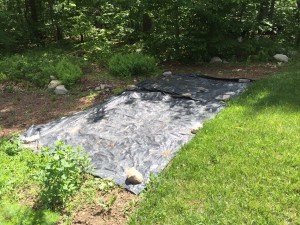Hello fellow readers, Last week, we spoke about George’s weedy invasion resulting in the need for a garden do-over. Thankfully, he opted for a more organic approach, including a non-chemical remedy called soil solarization. Here’s how.
Preparing your garden for planting is essential, as disturbing the soil after solarization can stir up new viable weed seeds. Rototill, remove rocks and clumps of plant material, then level the bed to limit air pockets, reducing soil heating. Wet soil conducts heat better than dry and makes organisms more vulnerable; hence, your soil should be damp at least 12 to 18 inches.
In general, clear plastic is most effective as the sun’s rays pass through the sheet and are trapped below, while black plastic absorbs and deflects part of the heat. The thinner the plastic, the greater the heating, but it is more susceptible to tearing, so slightly thicker plastic (say 1.5 to 2 mils) is best. However, black plastic in colder areas like here prevents weeds from growing beneath it when the air temps are too low.
The plastic must be tight against the soil. One way is to dig a trench 6 inches deep all around, then cover the edge with soil while pulling the plastic as tight as possible.
Some say the best of both worlds is to create a greenhouse effect by first covering the soil with black plastic. Then add a layer of clear plastic, creating an air space with water bottles or PVC pipes. The two-layer technique can raise soil temperatures an additional 10°F towards the goal of 110 to 125°F in the top 6 inches.
Generally, you need 6 to 8 weeks to ‘cook’ your soil during the year’s hottest months. In the Northern parts of the country, it’s better to leave the plastic on all growing season.
Not only will soil solarization kill weeds, but it can also control pests such as fungi, bacteria, nematodes, insects, and mites. And it speeds up the breakdown of organic material, increasing the availability of nitrogen and other nutrients for growing healthy plants.
Not to worry, worm lovers. Many beneficial organisms can survive solarization or recolonize quickly, and earthworms are thought to burrow deeper down to escape the heat.
Garden dilemmas? askmarystone@gmail.com and your favorite Podcast App.
Column updated 8/3/22



